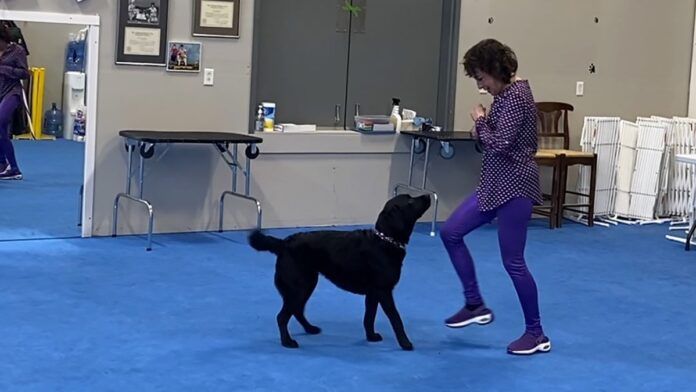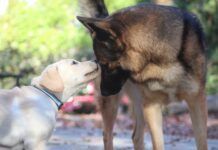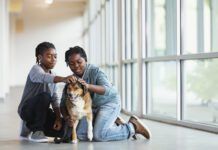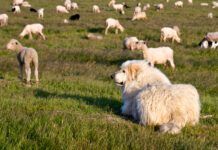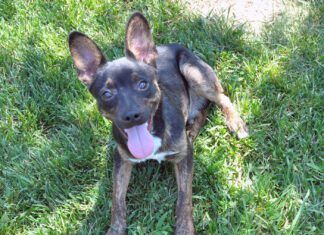If you like teaching your dog tricks, you might like dog dancing. Dog dancing is all about the connection and bond between a handler and their dog. Dog and handler teams perform routines of tricks and skills linked together to music. Routines can tell a story, can be lyrical, and have fun themes. Dogs and handlers often dress up for their performances and can have fun props to interact with as well.
There are two different types of dog dancing in the United States The first is Musical Freestyle. “Musical Freestyle is anything goes,” says Jan Meyer, a dog dance instructor based in Colorado. “You can do any fun things you want with your dog. They can jump, they can go through your legs, you can come up with anything and it’s fine.”
The other type of dog dancing is heelwork to music, which has stricter rules. “Heelwork to Music, the dog has to stay within two feet of you, front, sides, and back,” says Meyer. “They can’t go through your legs, they can’t jump, so you can’t do weaves, figure eights, you can’t have them go to the other side of the ring. So it’s really like a partnership kind of dance.”
Whether you decide to try out Musical Freestyle, Heelwork to Music, or both, dog dancing is an incredibly beginner-friendly sport, but it takes some knowledge to get started.
How to Get Your Dog Started in Dog Dancing
Currently, dog dancing is more popular in Europe than in the United States, but there are still a number of ways to get involved. Jess Anderson, a dog dance competitor and instructor located in Colorado, suggests looking for a local club. She also encourages dog dance enthusiasts to start their own club if none exist in their area.
“Unfortunately in the U.S., I think that Musical Freestyle is very limited to certain specific geographical locations,” says Gin Brophy, a dog dance instructor and competitor located in Michigan. “I wouldn’t be surprised if a lot of areas simply don’t have any options for classes or competitions or even private instruction in the sport. If you’re lucky enough to have a class in your area, that would certainly be a good starting point to start learning about the sport and build some connections.”
Brophy also recommends looking into the World Canine Freestyle Organization (WCFO), which is one of few if not the only truly active dog dance groups in the country. Their website is currently getting overhauled but is normally a good resource to look into to find out if there’s a club in your area.
If there’s no club near you or if you’re brand new to the sport, there are other options for trying out dog dancing. Some instructors offer virtual training options, and Anderson also recommends joining the Dog Dance USA Facebook group. “It’s a central hub spearheaded by a small group who are determined to bring Dog Dance to the U.S. more and more,” she says.
Brophy teaches virtually through her website, everydaywonderdog.com, and is happy to train interested dog and human teams. She also recommends Michele Pouliot’s online freestyle course as an intro to the sport.
How to Find and Enter Dog Dancing Events
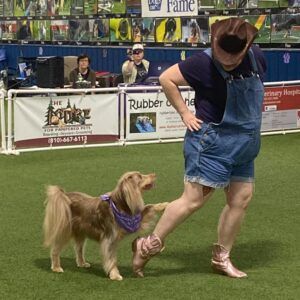
If you’ve taught your dog some skills, taken an in-person class, or studied up virtually, competition is the next natural step for dog dancing. Though there are more groups that offer dog dance titling in Europe, WCFO is the main way to title your dogs in Heelwork to Music and Musical Freestyle in the United States, says Anderson. “The live competitions are far and few between in the U.S., but you can enter videos virtually.”
Local dog dancing clubs, like Boogie Paws run by Jan Meyer, offer virtual trials as well. The beauty of virtual competitions is that you can enter them regardless of where you live. WCFO also offers virtual monthly video events, where competitors can submit videos to be scored for legs towards their titles.
At the time of writing, the WCFO website was undergoing a website overhaul, but Anderson and Meyer say that live and virtual competitions are usually posted there on the calendar tab. For now, it’s best to join a Facebook group or get in contact with a local trainer or club for more info on local competitions.
Because dog dancing trials tend to lean more virtual than in-person, this is a great sport for reactive or nervous dogs. Meyer says that during in-person events, crate space is quite close to the ring and the live trial environment can be challenging for some dogs. With virtual competitions, any dog can try out the sport.
How to Earn Dog Dancing and Freestyle Heelwork Titles
Through WCFO, you can earn titles for Beginner, Novice, Intermediate, Advanced and Perfect Dance Partner (PDP) for both Heelwork to Music and Musical Freestyle. To earn titles, teams have to perform a routine based on a time limit (determined by level). Teams are scored artistically and technically, similar to gymnastics or ice-skating routines.
For the Beginner level, teams need two qualifying scores of 7.3 or above to earn their title. Novice, Intermediate, and Advanced require three qualifying legs with scores of 7.3 and above. Lastly, Perfect Dance Partner requires 5 qualifying legs of 9.5 or above.
According to Meyer, at the Beginner level for Musical Freestyle, judges are mainly looking for a connection with your dog. The dog might do simple turns and spins, figure eights, and heelwork. In Novice, judges look for fewer hand signals and a little bit more polish. In Intermediate, judges want behind work, where the dog does skills from behind you. In Advanced, judges want to see distance work. Once you get to PDP, judges look for zero hand signals and complete connection and flow with your dog.
There are also special divisions in WCFO dog dancing, like Sassy Seniors (which has age limits), and Handi Dandi (for dogs or handlers with handicaps). These different classes aim to make dog dancing more inclusive for different demographics.
Should I Try Dog Dancing with My Dog?
“One of the reasons I love dog dance so much is because truly any dog can do it,” says Anderson. Anderson has done dog dancing with her dog, Jack, and credits the sport with building their relationship and Jack’s confidence. Anderson has also done dog dancing with foster dogs and her older, deaf dog, and says that the sport is truly for any breed, age, or personality.
A common misconception about dog dancing is that you need to know how to dance to do it. Meyer says that handlers don’t need to know how to dance at all to get involved in the sport. She says if your dog can walk next to you, they can learn to dance.
“It’s really fun and relaxed, and a lot lower pressure than some other sports,” says Brophy. She says that dog dancing is a great sport to show off the handler’s creative sides through routine choice, music, and costumes, and that the community makes it a very beginner-friendly sport. Because dog dancing isn’t that big in the United States, Brophy says that people tend to be welcoming and encouraging because they want to see the sport grow and become more accessible.
“To anyone who might be nervous or think their routine or their dog won’t be ‘good enough’, just remember that dog dancing is art, and art is subjective, so there’s no possible way to do it wrong,” Brophy says. “Teach your dog a few tricks, put on some music, and you’re already doing it!”


